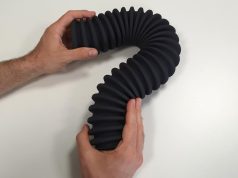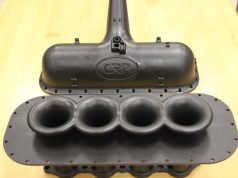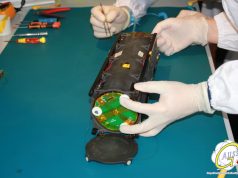CRP Technology’s long-term collaboration with the unmanned airborne solutions developer, Award-winning FLYING-CAM brought to the construction of the UAV Discovery’s tail rotor gear box housing. The part is 3D-printed in Windform® XT 2.0 composite material and it is flight-ready with a good weight-resistance ratio
FLYING-CAM, the world leader in design and manufacturing of unmanned helicopters and pioneer of professional drone filming services, celebrated its 30th anniversary with the World premiere of Discovery, its newest unmanned aircraft system.
The Belgium-based company decided to turn to CRP Technology and its advanced solutions for Additive Manufacturing using Powder Bed Fusion (PBF) process with composite polymers fiber-reinforced, in order to complete the construction of Discovery.
The project
Discovery is a 75kg Maximum Take-Off Weight (MTOW) unmanned single rotor helicopter, so far FLYING-CAM’s largest and most versatile system with increased endurance features.
FLYING-CAM involved CRP Technology in the manufacturing of Discovery’s tail rotor gear box housing, that is the main housing attached to the main tail boom.
Emmanuel Previnaire, founder and CEO of FLYING-CAM, says, “With the potential drones offer the civil market, and the interest in Beyond Visual Line Of Sight (BVLOS) flights, we felt it was the right time to develop a drone that could not only capture beautiful imagery for movies, television shows and commercials, but that could carry a variety of payloads to collect the necessary data for other Industrial applications.
The result was the creation of the “super drone” named Discovery, fully integrated with the state-of-art sensors carefully chosen to match the supreme platform quality for a variety of applications ranging from Entertainment Industry, Homeland Security, Earth Monitoring, and in general High Precision Remote Sensing.”
To complete such an unrivalled drone, FLYING-CAM needed to count on a capable and up-to-the-challenge technological partner, able to maintain its high quality standards in the construction of reliable components. For those reasons, FLYING-CAM opted for CRP Technology’s Additive Manufacturing solutions with its proprietary high performance Windform® TOP-LINE range of composite materials.
The 3D printed functional part
The aim of the project was to create a lightweight yet rigid physical and aerodynamic protection for the tail rotor actuators and the GPS antenna of the MTOW Unmanned single rotor helicopter named Discovery.
CRP Technology, according to FLYING-CAM’s requirements and standard, opted for a 3D printing process with composite polymers fiber-reinforced (Powder Bed Fusion – PBF; specifically Selective Laser Sintering) and Windform® XT 2.0 as construction material.
Windform® XT 2.0 is a ground breaking, Carbon fiber filled polyamide based 3D printing composite, particularly suitable in demanding applications for such a sector as motorsports, aerospace, and UAV.
It replaced the previous formula of Windform® XT in the Windform® TOP-LINE family of materials for PBF created by CRP Technology, featuring improvements in mechanical properties including +8% increase in tensile strength, +22% in tensile modulus, and a +46% increase in elongation at break.
The choice of the material has been very accurate, as the part to-be was conceived to withstand specific issues: “The component – Emmanuel Previnaire adds – was planned to be clamped on the tail boom, and support also the Carbon plate used as a tail rotor ground protection. For this reason, a good stress resistance was needed.
The clamping strength depends on the construction material’s capabilities. We have chosen Windform® XT 2.0 as it allows us to achieve it with a good weight-resistance ratio.”
The mechanical and thermal properties of Windform® materials are strictly connected to the characteristics of the 3D printing manufacturing process. Indeed, the combination of both produces unparalleled, highly technological 3D printed parts, ready to be used.
Emmanuel Previnaire underlines, “The most innovative aspect in enlisting the 3D printing process and composite materials supplied by CRP Technology, is the free shape design, important for aerodynamic purpose, as well as the ability to create complex wiring channels inside with strong attachment points, in one unique piece.
Being more specific, PBF process and Windform® materials allow the creation of hollow parts with a lot of functional details, such as fixation nuts integration, cable attachment points. This is a very added-value that perfectly suited our purposes and standards.”
The importance of the right technological partner
FLYING-CAM’s systems have changed over the years, in order to be up-to-date with the market requests.
“In the past – Previnaire specifies – you could stay in business with a product for 15 years. Now, every six months you need to update. For that reason, we designed a platform that follows the pace of technology. To keep up with the ever-changing technology in the UAS industry, and to obtain the highest levels of reliability, safety, precision and adaptability to take on a variety of missions, such as mapping and inspections, we rely on partners who not only offer cutting-edge technological solutions, but are forerunners of technological innovations at the maximum level, and CRP Technology is among them.
We started collaborating with CRP Technology many years ago, for the realization of SARAH 3.0, our electric Vertical Take-Off And Landing (VTOL) unmanned aerial system, now replaced by SARAH 4.0.
CRP Technology 3D printed the airframe structure, air guide cooling system, tail unit and main battery connection.”
SARAH, as well as Discovery, is a cutting-edge “unmanned aerial intelligence” solution and only possible by mastering all the technologies and skills involved.
In 2014 FLYING-CAM was awarded with the Oscar® for Scientific and Engineering Award for SARAH’s development. The citation reads, with unparalleled sophistication, FLYING-CAM’s SARAH achieves shots impossible for full-size helicopters, cable systems or other traditional camera support devices.
Previnaire states, “We are not outsiders as we won 2 Oscar Award ® and 1 Emmy Award®, but this specific Sci-Tech award fills us with pride as it is a further attestation of our professional approach, which is always to strive for excellence, and apply general aviation knowledge and airmanship. This distinguished method not only will continue to push the company’s engineers towards the summit of achievement, but also it guides us in the choice of manufacturing partners, who must demonstrate with facts that they are on the same wavelength as us. Starting with SARAH, our collaboration with CRP Technology has continued ever since.”
crptechnology.com
windform.com
Subscribe to our Newsletter
3DPresso is a weekly newsletter that links to the most exciting global stories from the 3D printing and additive manufacturing industry.






















